The organization known today as Presbyterian World Service and Development has a rich history. Its past is full of interesting characters, difficult situations, disasters—both natural and human-made—and a lot of love and devotion. Here are only a few of the highlights from 65 years of international aid:
1947:

In the wake of World War II, the 73rd General Assembly asks “that our people be called upon to hear and respond to the cry of British and other European peoples in their desperate need for food, clothing and practical help; and that in the spirit of David who would not offer to the Lord that which cost him nothing (2 Samuel 24:24), we who are so richly blessed in this Dominion endeavour to make some real sacrifice for our brethren’s sakes; and that in each congregation some organization be set up, or some existing organization utilized, for the collection and transmission through the proper government agencies, of such gifts as our people may make for European relief.”
The Board of Evangelism and Social Action—a committee concerned with spreading the gospel and upholding Christian morality—creates a subcommittee to help direct donations through the World Council of Churches. During its first five months, the committee ships 57 tons of clothes to Great Britain, the British Zone of Germany, France, Greece and Japan; $4,200 is provided to buy food in Bavaria, Holland and Great Britain.
1948:
Relief efforts expand include Asia.
1954:
General Assembly agrees one appeal for “World Church Relief” should be made each year. This usually happens before Easter.
1959:
The World Council of Churches and Canadian Council of Churches urge their member denominations to emphasize “Refugee Year” and “recognize by our contributions how much more fortunate we are than the harassed parents of families flooding into India from Thibet [Tibet] or than the pathetic children living on the sidewalks of Hong Kong.”
1962:
The Relief Abroad committee changes its name to the Committee on Inter-Church Aid, Refugee and World Service.
Its convener, Rev. Eoin Mackay, suggests $100,000—or 60 cents a year from each member—should be the goal for 1962. “I’m not talking about generosity,” he writes in his report to assembly. “Five cents a month isn’t a matter of generosity. I can’t imagine a Presbyterian … having the gall to give less or to say it would diminish his support of the General Assembly’s budget.”
By the end of the year, churches and individuals have contributed $25,000—$3,000 less than the year before.
1966:
The church rallies to support India as food shortages threaten to become a famine. An appeal for $85,000 results in $131,000 for India and $171,000 in total donations.
1968:
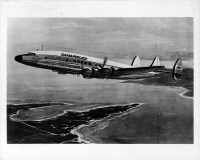
“was the most outstanding year in the history of our Church’s participation” in international aid, the committee reports. Over $213,000 is raised and $176,000 goes to relief efforts in Nigeria-Biafra, a region embroiled in civil war.
Those relief efforts include the formation of “Canairelief, the first public-sponsored aircraft operation in Canada’s history.”
“Our Canadian Super-Constellation plane was added to the Jointchurchaid fleet and because of its large capacity and the skill and daring of its crew has achieved the highest record of tonnage transported,” the committee bragged in its report.
1970:
“Although emergency feeding and housing are important, more and more we see the need and the benefit of development aid, helping people in underdeveloped areas to help themselves,” the committee writes.
“Certainly at the time I was on the Inter-Church Aid committee, there was very little in the way of development work,” remembers Marjorie Ross, a committee member from 1971 to 1977 and the second director of Presbyterian World Service and Development. “It was channeling responses from Canadian Presbyterian congregations and some individuals to appeals from the World Council of Churches, usually for victims of natural disasters. The focus was always on what would now be considered relief as opposed to development. Now of course values of money have changed a lot since the ‘70s, but I remember that $70,000 was not a bad sum for the committee to collect in a year, so it was a pretty small operation.”
1971:
The Presbyterian, Anglican, Lutheran, Roman Catholic and United Churches create a working body called the Inter-Church Consultative Committee on Development and Relief. A subcommittee is set up to help co-ordinate disaster responses. They also work together on educational programs.
The Presbyterian committee helps develop two projects that receive matching grants from the Canadian International Development Agency. The first is a series of “special development projects in Malawi, Indonesia, the Philippines and North Africa.” For the second, the PCC kicks in $26,000—and the United Church adds $9,000—to build a permanent hospital in West Bengal, India, where refugees from Pakistan and the local population are overwhelming a field hospital.
“The political tensions in East Pakistan, leading to the displacement of millions and finally to open hostilities with India, stirred the compassion of many,” the committee writes.
1974:
The five Canadian denominations chip in to create the Inter-Church Fund for International Development, which is expected to receive “substantial funding by CIDA, with a minimum of detail required in application procedures.” The PCC also receives matching funds from the governments of Alberta and Saskatchewan.
The committee hires its first paid staff person: a part-time secretary.
1978:
CIDA increases its matching grant ratio to 3:1 for most development projects.
The PCC, through its donations to the WCC’s Programme to Combat Racism, becomes involved in controversy when the WCC program gives an $85,000 grant to the Patriotic Front of Zimbabwe. The Inter-Church Aid committee supports a critical review.
1980:
The committee’s name is changed to Presbyterian World Service and Development.
“I had worked for several years trying to get the name changed because it had nothing to indicate the Presbyterian Church,” says Ron McGraw, who convened the Inter-Church Aid committee from 1975-1980. “The other groups all had something that identified them denominationally in all their names. They had Lutheran World Service, Canadian Catholic Organization for Peace and Development… We were the only ones with nothing to say to people ‘This is our church doing this.'”
1981:
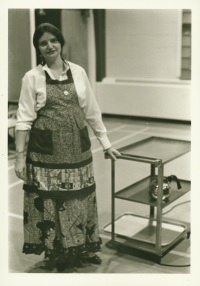
The PWS&D committee stresses that it “continues to place major emphasis on development aid which enables people to … permanently improve their living conditions.” It has supported projects in 17 countries and, though the Inter-Church Fund, has participated in almost 60 projects valued at just under $2 million.
“That seemed to me to be a time when there was a growing sense of organization, a growing professionalism within the agency,” says Tom Rodger, PWS&D committee member from 1980-1986. “At that point we were moving from being a purely voluntary agency where volunteers did all the work. We were really trying to discover or to develop policies regarding personnel, policies having to do with our relationship with CIDA, policies having to do the kind of development and relief and refugee and what-have-you projects that we were funding.”
1984:
“Where things really changed was in 1984,” says Jean Davidson, a PWS&D staffer who became its first director. “There was a famine in Ethiopia. It was on the nightly news and right in people’s living rooms. The money was just rolling in and we had to get some staff in to help address that. And that picked up the momentum of people saying, ‘How can we make sure that this doesn’t happen again? What kind of programs could be put in place so that you don’t have to keep addressing famines?'”
1986:

In order to house its five staff people in the church’s national office in Toronto, the committee pays for renovations to “an area not previously used for office space to make an efficient and attractive environment.” A sixth staff person works in Edmonton.
1987:
Jean Davidson is hired as PWS&D’s first full-time director (a position equivalent to an associate secretary). Also for the first time, more than a million dollars is expended on projects overseas.
“Sometimes it was just getting the word out that was the real challenge, and I was functioning in the days pretty much before fax and certainly before email,” Davidson says. “Sometimes we got emergency requests and you’d have to laboriously send out 1,200 letters requesting help. If it was an emergency, well, the letters took till the next week to get there and then the cheques had to come back. It was a slower process.”
1989:
Jean Davidson resigns. Dr. Richard Allen is appointed acting director until a replacement is found.
1990:
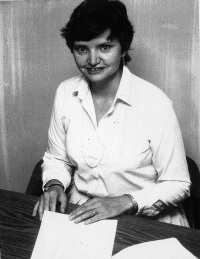
Marjorie Ross is appointed interim executive director as the national offices prepare for restructuring.
1991:
At the urging of CIDA, PWS&D restricts 80 per cent of its funding to three geographic areas: eastern and southern Africa, Central America and India/Pakistan. “The intent is to move away from being an agency which makes funds available to projects [and] towards being a program agency which is working with its overseas partners to achieve specific goals,” the committee reports.
1992:
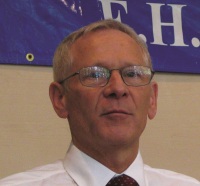
PWS&D becomes a part of the newly formed Life and Mission Agency within the PCC. Rev. Rick Fee is appointed director.
“At the General Assembly of ‘92, several commissioners brought forward a challenge that PWS&D should join the Canadian Foodgrains Bank,” says Fee. “Hitherto, it was felt that we should strictly concentrate on doing community development and not emphasize international relief. But joining the Canadian Foodgrains Bank, that opened the door to greater involvement with other agencies that were active in emergency relief. … I got very involved with the Canadian Foodgrains Bank and within about four months found myself in the middle of Somalia, in the middle of a war. Since that time I’ve felt that 1992-1993 was the beginning of the new wave of international disasters and the human community’s response.”
1994:
CIDA approves long-term program funding for PWS&D. Previously, the church agency received funding on a project-by-project basis.
PWS&D no longer seeks funds from the Alberta government because the source has been transferred to a foundation which, in turn, is funded by lotteries.
1995:
PWS&D is a founding member of Action by Churches Together, an agency to co-ordinate relief efforts worldwide.
1996:
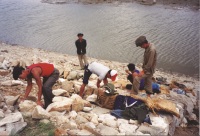
PWS&D becomes CFGB’s lead agency for a project that ships 3,350 metric tons of food a year to North Korea.
1997:
The Inter-Church Fund for International Development amalgamates with a CCC committee to become the Inter-Church Action coalition.
1998:
Hurricane Mitch strikes Central America. Presbyterians send $630,000 to the appeal by the end of the year.
PWS&D becomes the administrating body for refugee sponsorships undertaken by PCC congregations.
2000:
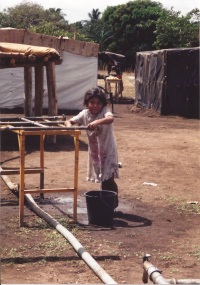
Undesignated donations to PWS&D exceed a million dollars.
A new group combining 12 social justice coalitions holds its inaugural meeting in Toronto. In 2001, it is named Kairos: Canadian Ecumenical Justice Initiatives.
2001:
“I was on the committee when [the Gujarat] earthquake hit,” says Rev. Dr. Andrew Johnston, convener of the PWS&D committee from 2002-2006. “It was January 26th—the Republic Day of India. Everybody was celebrating the independence of India, and there was this massive earthquake in a remote area. Twenty thousand people were killed in the matter of two minutes. Four hundred thousand homes were destroyed. It was just colossal.
“The amazing thing was that within hours the Church of North India had … supplies there—long before any global organizations had even raised money, much less got it to India, much less purchased supplies.”
2002:
“The [Life and Mission] Agency is aware that Presbyterian World Service and Development is where the mission of the Presbyterian Church in Canada has been expanding most rapidly,” the LMA says in its report.
PWS&D joins the Geneva-based Ecumenical Advocacy Alliance, which tackles issues of global trade and HIV/AIDS.
2004:
Rev. Dr. Rick Fee is elected moderator of the 130th General Assembly. The assembly launches the Toward a World Without AIDS campaign, which aims to raise $500,000 over and above givings to PWS&D and Presbyterians Sharing.
“It really was a major departure, a major new initiative for PWS&D,” says Johnston. “It put this as a challenge to the national church: HIV/AIDS is a pandemic. Initially in North America it was seen very much as a gay thing and even a judgment thing. It began with a very negative connotation and we felt we had to get on top of this; we had to do something public that would hold this up as a pandemic—not of a particular people or place, but as a challenge for us to respond to with compassion and strength.”
2005:
An appeal following a tsunami in the Indian Ocean on Dec. 26, 2004, raises more relief funds than any previous emergency appeal. By March, over $1.2 million has been contributed to PWS&D. The Presbyterian, United, Methodist and Anglican groups create a coalition to prepare a $6-million proposal for government funds.
“It was like the phone was ringing off the hook, I remember,” says Guy Smagghe, senior program co-ordinator at PWS&D. “We were working late nights to make all this programming happen. It was Dec. 26 [2004, that the tsunami hit] and I remember contacting all the partners to see if they had been affected and offering whatever assistance we could at the time. That became very important after because our partners knew we were there for them.”
2006:
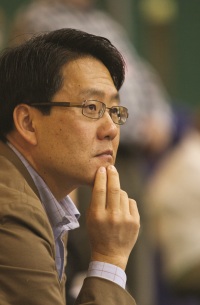
Ken Kim becomes director.
PWS&D’s annual grant from CIDA increases from $398,000 to $458,000 per year and a five-year agreement replaces previous three-year agreements.
2007:
In a partnership that began with joint responses to the tsunami, 10 churches—all of them members of CFGB—create Canadian Churches in Action to work together on non-food related relief.
The Toward a World Without AIDS campaign wraps up in November; it raised $1.58 million.
2009:
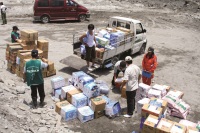
2010:
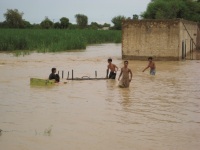
A devastating earthquake strikes Haiti. Presbyterians rally to contribute $1.6 million for Haiti and $4.1 million in total donations. Support is also sent to Pakistan in the wake of disastrous flooding, to Taiwan after Typhoon Morakot and to other nations struck with earthquakes and tropical storms.
2012:
PWS&D celebrates its 65th anniversary. “I believe that the compassionate and bold ministry of PWS&D will remain strong,” says Director Ken Kim. “You can see in our history how we’ve developed, learning, improving and meeting the challenges to the best of our ability. We will continue to do so as long as our church exists and wants PWS&D to carry out its mandate.”

